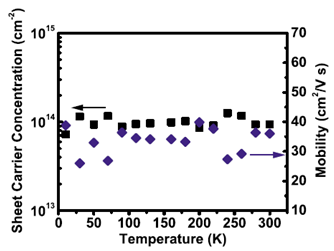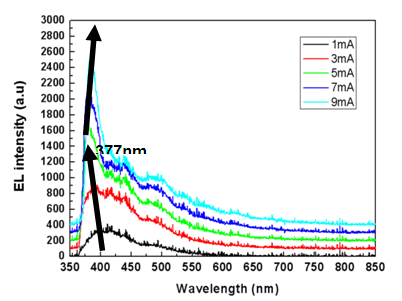 |
|
 |
| |
发行人:林清富所长 编辑委员:陈奕君教授 主编:林筱文 发行日期:2010.12.15 |
| |
|
|
 |
 本所孙启光教授荣获中华民国光电学会「九十九年光学工程奖章」,特此恭贺!
本所孙启光教授荣获中华民国光电学会「九十九年光学工程奖章」,特此恭贺!
 本所吴忠帜教授执行有机光电显示器跨学门科技人才培育计划,荣获
「教育部2009年度大学跨学门人才培育衔接计划~优良计划优等奖」,特此恭贺!
本所吴忠帜教授执行有机光电显示器跨学门科技人才培育计划,荣获
「教育部2009年度大学跨学门人才培育衔接计划~优良计划优等奖」,特此恭贺!
本所12月份演讲公告:
|
日期 |
讲者简介 |
讲题 |
地点 |
时间 |
|
光电论坛 |
|
12/21 (Tue) |
Prof. Ming C. Wu
Department of
Electrical Engineering and
Computer Sciences &
Berkeley Sensor and Actuator
Center, University of
California, Berkeley |
Semiconductor
Nanolasers |
博理馆
101演讲厅
|
10:00~12:00 |
|
|
 |
|
 |
|
| |
|
|
|
|
|
|
 |
|
11月份「光电论坛」演讲花絮(花絮整理:姚力琪) |
|
时间: |
2010年11月4日(星期四)上午10点 |
|
讲者: |
古培正教授(Department of
Electrical Engineering and Computer
Science, University of Michigan) |
|
讲题: |
Scaling of Semiconductor
Lasers and Solar Cells Using Plasmonics |
|
|
古培正教授于11月4日(星期四)莅临本所访问,并于电机二馆105演讲厅发表演说,讲题为「Scaling
of Semiconductor Lasers and Solar Cells
Using Plasmonics」。 |
| |
|
|
时间: |
2010年11月12日(星期五)下午3点30分 |
|
讲者: |
陈坤基教授(State Laboratory of
Solid State Microstructures and
Department of Physics, Nanjing
University) |
|
讲题: |
Silicon Based Photonic
Quantum Dots and Photonic Molecules |
|
|
陈坤基教授于11月12日(星期五)莅临本所访问,并于博理馆101演讲厅发表演说,讲题为「Silicon
Based Photonic Quantum Dots and Photonic
Molecules」。陈教授的主要研究领域包括奈米半导体材料、奈米量子电子学和奈米光电子学,本所教师及学生皆热烈参与演讲活动,陈教授演讲内容精彩,演讲时面面俱到,与本所师生互动佳。 |
| |

本场演讲者陈坤基教授
|
|
时间: |
2010年11月30日(星期二)上午10点30分 |
|
讲者: |
Prof. Ajoy Kar(Physics
Department, Heriot Watt University) |
|
讲题: |
Laser Written Active and
Passive Waveguide Devices |
|
|
Prof. Ajoy
Kar于11月30日(星期二)莅临本所访问,并于电机二馆105演讲厅发表演说,讲题为「Laser
Written Active and Passive Waveguide
Devices」,本所教师及学生皆热烈参与演讲活动,获益良多。 |
| |

本场演讲者Prof. Ajoy Kar
|
|
时间: |
2010年12月1日(星期三)上午10点30分 |
|
讲者: |
Prof. Min Qiu(KTH Royal
Institute of Technology) |
|
讲题: |
Plasmonic Metamaterial
Absorber at Optical Regime |
|
|
Prof. Min
Qiu于12月1日(星期三)莅临本所访问,并于电机二馆105演讲厅发表演说,讲题为「Plasmonic
Metamaterial Absorber at Optical
Regime」。Prof. Min
Qiu演讲内容丰富精彩,与现场同学互动性佳,本所师生皆获益良多。 |
| |

本场演讲者Prof. Min Qiu
|
|
时间: |
2010年12月2日(星期四)上午11点 |
|
讲者: |
林清隆教授(Bell Labs and
Bellcore (USA, retired); Formerly
Professor of Photonics and Director,
Center for Advanced Research in
Photonics, Chinese University of Hong
Kong) |
|
讲题: |
光纤通讯与宽带全球网络---向2009诺贝尔物理桂冠高锟教授致敬 |
|
|
2010
年是低损耗光纤诞生四十周年纪念。专为高速长程通信系统而开发的光纤,以其几乎无限的通信容量完全改变世界。现今透过广泛部署的全球光纤网络启用,已在世界各地形成宽带信息基础设施,展现功能强大与无远弗届的高速电信能力。2009年10月,香港中文大学前校长高锟博士
(Prof. Dr. Charles K.
Kao),光纤通讯开拓史中的先驱者,以其催生低损耗光纤这个无与伦比的贡献,与发明CCD
数字电子成像设备的贝尔实验室博伊尔博士(Dr. W.
Boyle)与史密斯博士(Dr. G.
Smith),共同荣获2009诺贝尔物理学奖桂冠。本讲座内容包括在光子学与光纤通信研发的早期故事,以及光纤与全球宽带互联网对现代人类信息社会的重要影响。谨以这个研讨会特别演讲为颂词,盛赞高锟教授诺贝尔物理奖荣耀。 |
 |
 |
| 本场演讲者林清隆教授 |
2009诺贝尔物理桂冠高锟教授来访电机信息学院 |
|

高锟教授夫妇(左三及左四)接受电机信息学院李琳山院长(右三)致赠纪念品,并于院长室合影留念
|
本所特聘讲座教授孟怀萦博士来访—(2010年11月16日) |
|
本所特聘讲座教授孟怀萦博士,于11月16日回到台大电机系发表演说,讲题为「Engineer,
Educator, and
Entrepreneur」(工程师、教育家和企业家),并分别和教师、学生对谈。 |
|

|
|
本所特聘讲座教授孟怀萦博士(中),与电机信息学院李琳山院长(左)、本所林清富所长(右)于院长室合影 |
|
 |
|
 |
|
| |
|
|
 |
|
~
与南京大学(Nanjing University)博士生交流活动 2010 系列报导 ~
【2010
两岸光电科技博士生论坛】
(The 3rd
Cross-Strait Ph.D. Student Forum on Photonic
Science and Technology, 2010)
(时间:2010年10月25日至10月26日;地点:台湾大学)
【之三】
花絮整理:光电所博士班学生苏亮宇
在第三届南京大学与台湾大学博士生交流活动中,对岸来的四位老师与十五位博士生进行了为期五天的参访活动,在这一系列的活动中,前两天为正式的交流研讨会,而在研讨会结束之后,我们也规划了一系列的参访行程,包括校内的台大物理文物厅、光电所制程实验室、故宫博物院、中正纪念堂、台北101等处,以及台湾集成电路、圆展科技等台湾知名企业。
第三天的参访活动从台大物理文物厅开始,展馆内主要展示亚洲最早期Cockcroft-Walton型直线加速器及其相关科学文物,由于参访团的成员主要皆为物理背景,因此对于这些文物表现出高度兴趣,特别是带团的王振林副院长,更不时与导览员展开热烈讨论。结束了文物厅的行程后,一行人漫步前往电机二馆,我们也为参访团员导览了椰林大道、总图等台大知名地标,在电机二馆内我们参访了光电所制程实验室、吴志毅老师实验室、林恭如老师实验室,在光电所制程实验室的参访中,参访团员对于光电所有如此完善之公用设备感到赞赏,在吴志毅老师与林恭如老师实验室参访中,也对于台大光电在前端研究之潜力感到敬佩。紧接着下午的行程我们前往故宫博物院、中正纪念堂、台北101等处,与他们分享台湾与中文的文化之美。
除了台大的校园、光电所实验室以及一些文化景点之外,我们也规划了台湾知名企业的参访行程,因此我们驱车前往新竹,参观的第一站为全球集成电路制造的龙头台积电,导览的魏烈妆经理极为礼遇我们,一直强调将所有团员当作贵宾看待,并且也详细地为我们介绍台积电,参访团员对于台积电惊人的制造能力也感到极为赞叹,在Q&A时间也不停的展开热烈的讨论,在导览结束后魏经理也展现地主之谊,邀请我们一同到台积电员工餐厅用餐,体会一些台积电不同的面向。接着我们驱车前往中和圆展科技,圆展科技由张永哲总经理、丁元迪副总经理等重量级人物接待我们,并且全程参与了整个参访活动,显示了他们对此活动的高度重视,此外圆展也精心规画了产品展示的活动,除了派出各研发小组的人解说之外,也以实际操作的方式展示给我们看,因此我们也在充满收获之下结束了参访的活动。
一系列的交流活动就在周末于饭店前的送行之后结束,台大代表与参访团员依依不舍地道别,期待明年台大代表到南京的参访,也能对双方的研究迸发出更多的刺激。
【之四】
花絮整理:光电所博士班学生洪士哲
第三届台湾大学与南京大学博士生交流活动由台湾大学规划举行,由南京大学物理学院祝世宁院长率领4位老师与15位学生来访。整个活动的安排包括了论文发表研讨会、实验室参访、校园巡礼及企业参访。交流研讨会于10月25日及10月26日正式举行,会议内容相当丰富深入,议程包括nonlinear
photonic devices, solid-state lighting and display, integrated optics devices,
laser optics and optical devices, nano-photonics, and optoelectronic
materials等主题,每位代表团学生成员有二十五分钟的演讲时间,演讲内容包括本身实验室简介与个人研究成果报告,会议期间除吸引多位非双方代表团成员的学生前来共襄盛举外,多位光电所的老师亦亲临会场给予与会者宝贵的建议与鼓励,为此次交流活动增色不少。在两天精采的学术交流中,我们充分感受到南京大学等大陆学校在研究工作上的投入与杰出成就,每位代表南京大学出席此次交流活动的学生代表都有相当高水平的研究成果,很高兴可以和如此优秀的朋友互相学习激荡。
在学术交流之外,我们也安排了文化参访及企业参访的行程,让远道而来的老师及学生可以体会台湾在地的风俗民情及文化。我们安排参观了国立故宫博物院、中正纪念堂、台北101等著名景点,同时也到了野柳、九份及士林夜市等地区性观光地点。在与南京大学的学生们聊天时得知,其实他们多数同学是第一次出国,而且由于经费问题,他们几乎很少有机会到欧美国家开会参访,绝大部分参加的会议都是在国内,所以他们也非常珍惜这次的交流活动。这也让我感受到应该更加珍惜我们所拥有的资源及机会。离开台湾时,他们带走了十多箱的凤梨酥、茶叶及其它台湾名产,也算是为台湾经济做出了些许的贡献。
此外,我们安排南京大学代表团参访相关实验室、研究中心及公司。除了参观所上多位老师的实验室外,还参观了物理系旧馆。南京大学物理系代表团的老师学生都对台大物理系的历史非常有兴趣。同时,我们亦安排参观台湾优秀的企业,包含到新竹参观台积电与台北的圆展科技的行程,感谢所有提供参观协助的单位,让南京大学物理系代表团可以有如此丰富的参访行程。
藉由参与此次活动,除了认识来自南京大学的朋友之外,也很高兴可以与其它同为光电所代表团学生成员的博士生更为熟悉,谢谢大家为整个交流活动的付出,大家辛苦了。最后,感谢光电所为我们开启了和南京大学物理学院进行交流的机会,也感谢老师林清富所长的推荐,使我得以在从事本身的研究工作之外,代表光电所和南京大学物理学院优秀的研究生进行学术交流。这是相当珍贵的经验与学习机会。最后,也感谢所办林筱文小姐为此活动所付出的心力,才能让活动如此成功。希望如此有意义的交流活动可以一直持续下去,让更多光电所的学生可以亲自体验与学习。
 |
 |
|
大陆老师及学生们参观物理旧馆 |
台湾学生及大陆学生于台北101合照 |
|
|
|
 |
|
 |
|
| |
|
|
 |
|
Two
Dimensional Electron Gases in
Polycrystalline MgZnO/ZnO
Heterostructures Grown by RF-Sputtering
Process
Professor I-Chun Cheng's group
Graduate Institute of Photonics and
Optoelectronics, National Taiwan
University
台湾大学光电所 陈奕君教授
We study the formation of
two-dimensional electron gas (2DEG) in
rf-sputtered defective polycrystalline
MgZnO/ZnO heterostructure via the
screening of grain boundary potential by
polarization-induced charges. The sheet
resistance reduces rapidly and then
saturates as the MgZnO thickness
increases. Both the mobility and the
sheet carrier concentration in
saturation increase as the Mg content is
raised and reach maxima of 39.4 cm2V-1s-1
and 1.15x1014cm-2
at x=0.4, confirmed by low temperature
Hall measurement. Monte Carlo method by
including grain boundary scattering
effect as well as 2D
finite-element-method Poisson and
drift-diffusion solver is applied to
analyze the polycrystalline
heterostructure. The experimental and
simulated saturation sheet resistance
show good agreement. Both carrier
concentration and mobility are
temperature independent, indicating the
formation of 2DEG with roughness
scattering at the MgZnO/ZnO interface.
Our result suggests that polycrystalline
MgZnO/ZnO material system can be a
potential candidate for the application
of low-cost large-area high electron
mobility transistor (HEMT) devices.
|
 |
|
Figure 1. Sheet resistance of
polycrystalline MgxZn1-xO/ZnO
heterostructure versus thickness of MgxZn1-xO
cap layer for x=0.15, 0.2, 0.3, 0.4, and
0.5. The lines are guides to the eyes. |
|
 |
|
Figure 2. (a) Hall
mobility and sheet carrier concentration
of MgxZn1-xO/ZnO
heterostructure in saturation as
functions of Mg content x. (b)
Comparison of experimental and
calculated saturation sheet resistances
as functions of Mg content x. The lines
are guides to the eye. |
|
 |
|
Figure 3. Hall mobility
and carrier concentration of Mg0.3Zn0.7O/ZnO
heterostructure with Mg0.3Zn0.7O
capping layer thickness of ~30 nm as
functions of temperature. |
Study of Carrier Dynamics and Radiative
Efficiency in InGaN/GaN LEDs
with Monte Carlo Method
Professor Yuh-Renn Wu
Graduate Institute of Photonics and
Optoelectronics, National Taiwan
University
台湾大学光电所 吴育任教授
In a LED, carriers are injected from the
contacts and diffuse laterally in the
quantum wells (QWs). In this paper, we
apply the Monte Carlo (MC) method to
study the carrier dynamics in the InGaN
QW. The radiative recombination rate is
calculated by a self-consistent Poisson,
drift-diffusion, and Schrodinger solver.
We set different dislocation densities
and trap cross sections of threading
dislocation, and study the influences to
the device efficiency by MC method. The
effects of alloy scattering, charged
dislocation scattering, interface
roughness scattering, and e-e scattering
are included in our MC model. The
locations of dislocations are arranged
randomly and are depending on
dislocation densities. The electron will
diffuse randomly by scattering in the QW
before recombination. If the electron
incidents into the location of the
threading dislocation, it is captured by
the threading dislocation and recombines
non-radiatively. The diffusion ranges
and the captured chances are influenced
by many scattering mechanisms and will
be discussed in this paper.
Our simulation result shows a strong
dependence on the indium composition
because of the longer radiative lifetime
in the longer wavelength due to QCSE.
The carrier diffusion length with higher
In composition increases because of a
longer radiative lifetime. However, the
diffusion length in a higher In
composition QW will decrease if the
interface roughness scattering is very
strong. The larger diffusion length
leads to a higher capture rate. To
estimate the internal quantum efficiency
(IQE), we need to define the carrier
capturing cross section diameter, δ. The
published TEM results show the threading
dislocation has a carrier trapping
diameter around a few nanometer. Within
these ranges, we start to estimate the
expected IQE. We find that with a larger
interface roughness, the IQE can be
improved by a few percent. If the δ
changes from 2nm to 4nm, the radiative
efficiency will decrease 20% to 30%. If
the dislocation density drops to 106
cm-2, the IQE can be improved
significantly. Since most LEDs are the
lateral LED, there would be a lateral
electric field in QW with a larger
applied bias. Our results show the
efficiency will drop 30% to 70%
depending on the In composition when
applying a small lateral electric field.
The carrier is easier to be captured if
it is drifting with a certain direction
rather than diffusing in a random
direction. This indicates that
non-radiative coefficient, A, is not a
constant and should be strongly
dependent on the bias, δ, and
dislocation density. Our estimated IQE
is compared with published experimental
results and shows a good agreement in
the trend. Our results show that for the
longer wavelength source, we should try
to decrease the radiative lifetime by
reducing the QCSE with a
nonpolar/semipolar structure. The other
way is to reduce the dislocation density
to be lower than 106 cm-2.
However, both should be achieved to make
the IQE reaching 100%.
|
 |
|
Fig. 1 (a) Estimated maximum
efficiency versus indium
composition for different
dislocation density values when
n2d is 8x1012
cm-2. Also shown is a
comparison with experimental
results. (b) Estimated e±ciency
versus indium composition with
different dislocation densities
for the nonpolar plane cases. |
|
|
|
 |
|
 |
|
| |
|
|
 |
论文题目:多模干涉分光器之改良设计
姓名:魏佐芸 指导教授:王维新教授
| 摘要 |
|
本文探讨截角式、加高式、结合式等三种特殊多模干涉一对多分光器(Multimode
interference power
splitters)。所谓截角式是考虑多模波导宽度有变化,加高式是考虑多模波导高度有变化,而结合式则是同时考虑截角与加高两种变化。仿真结果显示前两种变化加在多模波导的入射区时都可以提升多模干涉分光器的传输率(normalized
transmission
power)及减小不均匀度(uniformity),而且组件的干涉长度也可以缩短;第三种结合式则有两者加成之效果。
|
 |
 |
|
图一:渐变加高式多模干涉分光器 |
图二 |
|
论文题目:高效能可见光及紫外光发光二极管及其奈米结构之研究
姓名:柯闵咏 指导教授:黄建璋教授
| 摘要 |
|
我们利用射频溅镀(RF-sputtering)成长具有载子局限结构之氧化锌(ZnO)异质pn接面发光二极管,具有二氧化硅电流阻挡层(SiO2
current blocking
layer)之组件,其发光频谱峰值为394nm并大幅降低缺陷发光。而具有载子三明治局限结构之组件,能使载子能够更有效注入及局限于氧化锌发光层,达到377nm近紫外波长放光。
我们亦制作一具高光指向性之紫外光氧化锌奈米柱(ZnO nanorods)/氮化镓
(GaN)发光二极管。并在其界面加入一氧化镁电子阻挡层,透过此结构之设计,达到390nm近紫外放光,此组件显示出高度之光指向性且其发散角为30度,显示具奈米柱结构之氧化锌发光组件具有成为高指向性UV发光源之潜力。
|
 |
|
Fig. 1 EL
spectra of the GZO/ZnO/GaN LED
with SiO2
barriers. |
|
|
 |
|
Fig. 2
Radiation patterns of
p-GaN/MgO/ZnO naoarod arrays
exhibits waveguiding effect. |
|
|
|
|
 |
|
 |
|
| |
|
|
 |
—
数据提供:影像显示科技知识平台 (DTKP, Display Technology
Knowledge Platform) —
—
整理:林晃岩教授、陈韦仲 —
「用水就能制作半导体」,美国伦斯勒理工学院成功在石墨烯中形成能带隙
美国纽约伦斯勒理工学院(Rensselaer Polytechnic
Institute)宣布,该校研究人员成功地使用水在石墨烯中形成能带隙。论文已刊登在学术杂志《small》上。
石墨烯本身并没有能带隙,只具有与金属一样的导电特性。在此研究中证明了使用简单的方法即可使石墨烯产生能带隙。伦斯勒理工学院教授Nikhil Koratkar表示,此研究尝试的关键是「破坏石墨烯的对称性」。石墨烯没有能带隙主要是由于石墨烯薄膜具有高度对称性,只要能破坏该对称性,就能在其中形成能带隙。Koratkar教授的研究团队首先在二氧化硅底板上制作出石墨烯薄膜,然后将薄膜和底板一起放入保持一定湿度的容器中。藉此石墨烯吸收空气中的水分后,进而形成能带隙,此研究使用的方法是控制湿度使石墨烯薄膜表面吸收水分子,而与二氧化硅底板相接的那一面则无吸收,从而破坏了薄膜的对称性。而且可透过调节湿度,在0~0.2
eV的范围内可精确地设定能带隙值。这种变化是可逆的,只要放入真空中,就可使已形成的能带隙值回归于0。
在透过破坏对称性形成能带隙的方法上,将石墨烯加工成细带状、以及利用两层或三层石墨烯等方法也都被开发出来。Koratkar表示,「此次的方法具有低成本、无毒性以及带隙调节非常简单」的优点。此研究有助于使用石墨烯制作晶体管、二极管、奈米电子及奈米光子等应用。
|
 |
|
图一、
在二氧化硅底板上制作出的石墨烯薄膜、分析其导电性 |
|
中文新闻来源: |
http://big5.nikkeibp.com.cn/news/semi/53807-20101028.html |
|
英文新闻来源: |
http://news.rpi.edu/update.do?artcenterkey=2783&setappvar=page%281%29 |
|
论文来源: |
“Tunable Band
gap in Graphene by the Controlled Adsorbtion of
Water Molecules,”
published by the journal Small.
http://dx.doi.org/10.1002/smll.201001384
|
|
|
|
|
|
 |
|
 |
|
|
|
 |
|
 |
|